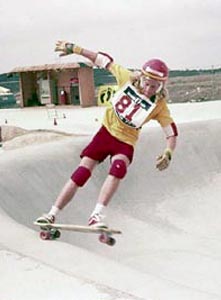![[Metroactive Movies]](/gifs/movies468.gif)
[ Movies Index | Show Times | Santa Cruz | Metroactive Home | Archives ]
Chairmen of The Board
'Dogtown and Z-Boys' chronicles the history of skateboarding
By Richard von Busack
STACY PERALTA'S Dogtown and Z-Boys has caught the ambience of a lost time and place, and that would seem even better than chronicling the beginning of a worldwide sport. To those who'd mainly thought of skateboards as a blessing for orthopedic surgeons, this documentary captures the excitement of skateboarding. The film provides an introduction to a popular sport, and it is more popular than we realize: the sale of skateboarding equipment exceeds that of baseball.
Since I'm not getting any of that money, what fascinates me is the footage of what director Peralta calls "the last seaside slum." He means that no-man's-land strip of Ocean Park between Santa Monica and Venice, Calif., as it was in 1975. The area's biggest landmark was the burnt-out ruins of Pacific Ocean Park: "Where the debris meets the sea." Daredevil surf fiends would smuggle their boards past the Keep Out signs and shoot through the water around the splintery timbers and rusty iron of what was left of P.O.P.
These surfers were territorial, defending this wreckage with rocks, bottles and other projectiles--Vals Go Home! Across the street from this mess sat the Zephyr surf shop, where designer Jeff Ho installed some funk into the art and patterns of the boards. Soon after came the Zephyr surf team--the "Z-boys" of the title.
The problem with surfing in Santa Monica Bay is that the wind comes up between the morning and evenings; to pass the time, these surfers would practice their moves on the newly revamped skateboards of the mid-1970s.
While skateboards were around in the 1960s, as Peralta demonstrates, the new plastic-derived wheels were a technological improvement on the cruder ceramic wheels, which would crack, lock and break. The traction of the improved skateboards allowed more play. These surfers--a lot of whom were denizens of the beat-up coastal zone they nicknamed "Dogtown"--began to exhibit a new high-flying style.
This aerialism was promoted by photographer Glen E. Friedman in the pages of Thrasher magazine and debuted at the Del Mar national skateboarding competitions in 1975. There, a group of demure suburban skaters met the future of skating in the form of the Dogtown Boys--"like a hockey team going to a figure-skating show."
Maybe only Peralta, who was there in '75, could have gotten these interviews from a lot of wary skaters who are middle-aged men now. But that doesn't give the director enough credit for the slaved-over, densely layered surface of this documentary.
Peralta uses satellite photos to pinpoint the different elementary schools where the best ramps were located, and he cuts still photographs into vintage motion-picture films of the skaters in flight. Since he's describing a kinetic sport in which the best performers can cut loose from gravity, the editing never seems like pointless flash. The smash-and-grab imagery feels right for a group of kids seen, as they thought they were, in an eternal "now."
[ Santa Cruz | Metroactive Central | Archives ]
Copyright © Metro Publishing Inc. Maintained by Boulevards New Media.
![]()
 Rim Shot: Stacy Peralta shows off his mid-'70s form.
Rim Shot: Stacy Peralta shows off his mid-'70s form.
Dogtown and Z-Boys (PG-13; 90 min.), a documentary by Stacy Peralta, opens Friday at the Del Mar Theatre in Santa Cruz.
From the May 15-22, 2002 issue of Metro Santa Cruz.